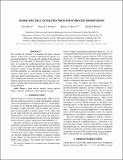Sparse spectral estimation from point process observations
Author(s)
Miran, Sina; Purdon, Patrick L.; Babadi, Behtash; Brown, Emery Neal
DownloadICASSP17.pdf (366.9Kb)
OPEN_ACCESS_POLICY
Open Access Policy
Creative Commons Attribution-Noncommercial-Share Alike
Terms of use
Metadata
Show full item recordAbstract
We consider the problem of estimating the power spectral density of the neural covariates underlying the spiking of a neuronal population. We assume the spiking of the neuronal ensemble to be described by Bernoulli statistics. Furthermore, we consider the conditional intensity function to be the logistic map of a second-order stationary process with sparse frequency content. Using the binary spiking data recorded from the population, we calculate the maximum a posteriori estimate of the power spectral density of the process while enforcing sparsity-promoting priors on the estimate. Using both simulated and clinically recorded data, we show that our method outperforms the existing methods for extracting a frequency domain representation from the spiking data of a neuronal population.
Date issued
2017-06Department
Institute for Medical Engineering and Science; Massachusetts Institute of Technology. Department of Brain and Cognitive SciencesJournal
2017 IEEE International Conference on Acoustics, Speech and Signal Processing (ICASSP)
Publisher
Institute of Electrical and Electronics Engineers (IEEE)
Citation
Miran, Sina, Patrick L. Purdon, Emery N. Brown, and Behtash Babadi. “Sparse Spectral Estimation from Point Process Observations.” 2017 IEEE International Conference on Acoustics, Speech and Signal Processing (ICASSP), March 5-9 2017, New Orleans, LA, USA, Institute of Electrical and Electronics Engineers (IEEE) June 2017 © 2017 Institute of Electrical and Electronics Engineers (IEEE)
Version: Author's final manuscript
ISBN
978-1-5090-4117-6
ISSN
2379-190X